wheel DODGE DURANGO 2022 Vehicle Warranty
[x] Cancel search | Manufacturer: DODGE, Model Year: 2022, Model line: DURANGO, Model: DODGE DURANGO 2022Pages: 200, PDF Size: 6.72 MB
Page 45 of 200
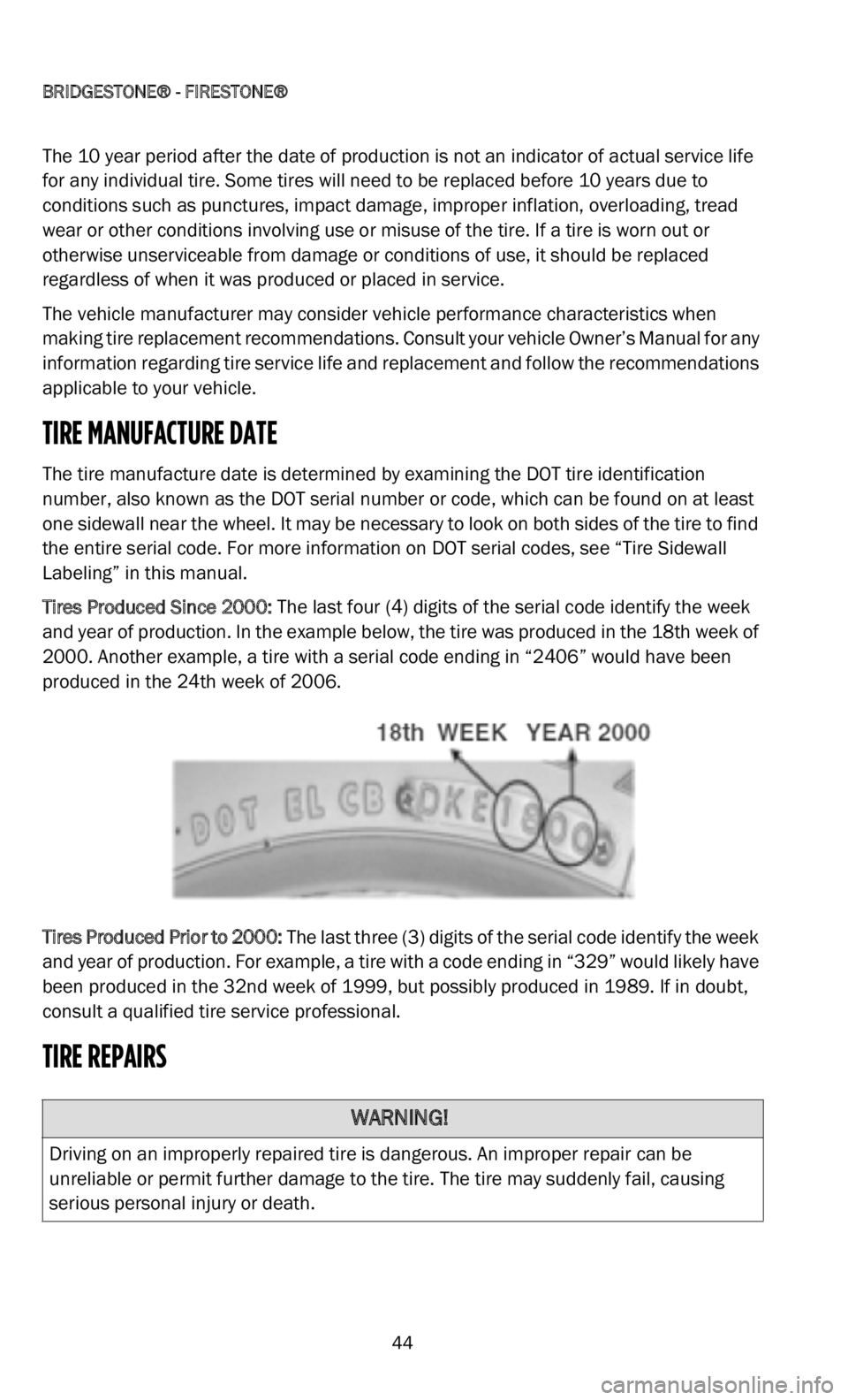
BRIDGESTONE® - FIRESTONE®
44
The 10 year period after the date of production is not an indicator of actual service life
for any individual tire. Some tires will need to be replaced before 10 years due to
conditions such as punctures, impact damage, improper inflation, overloading, tread
wear or other conditions involving use or misuse of the tire. If a tire is worn out or
otherwise unserviceable from damage or conditions of use, it should be replaced
regardless of when it was produced or placed in service.
The vehicle manufacturer may consider vehicle performance characteristics when
ma
king tire replacement recommendations. Consult your vehicle Owner’s Manual for any
information regarding tire service life and replacement and follow the recommendations
applicable to your vehicle.
TIRE MANUFACTURE DATE
The tire manufacture date is determined by examining the DOT tire identification
number, also known as the DOT serial number or code, which can be found on at least
one sidewall near the wheel. It may be necessary to look on both sides of the tire to find
the entire serial code. For more information on DOT serial codes, see “Tire Sidewall
Labeling” in this manual.
Tires Produced Since 2000: T
he last four (4) digits of the serial code identify the week
and year of production. In the example below, the tire was produced in the 18th week of
2000. Another example, a tire with a serial code ending in “2406” would have been
produced in the 24th week of 2006.
Tires Produced Prior to 2000: T
he last three (3) digits of the serial code identify the week
and year of production. For example, a tire with a code ending in “329” would likely have
been produced in the 32nd week of 1999, but possibly produced in 1989. If in doubt,
consult a qualified tire service professional.
TIRE REPAIRS
WARNING!
Driving on an improperly repaired tire is dangerous. An improper repair can be
unreliable or permit further damage to the tire. The tire may suddenly fail, causing
serious personal injury or death.
Page 46 of 200
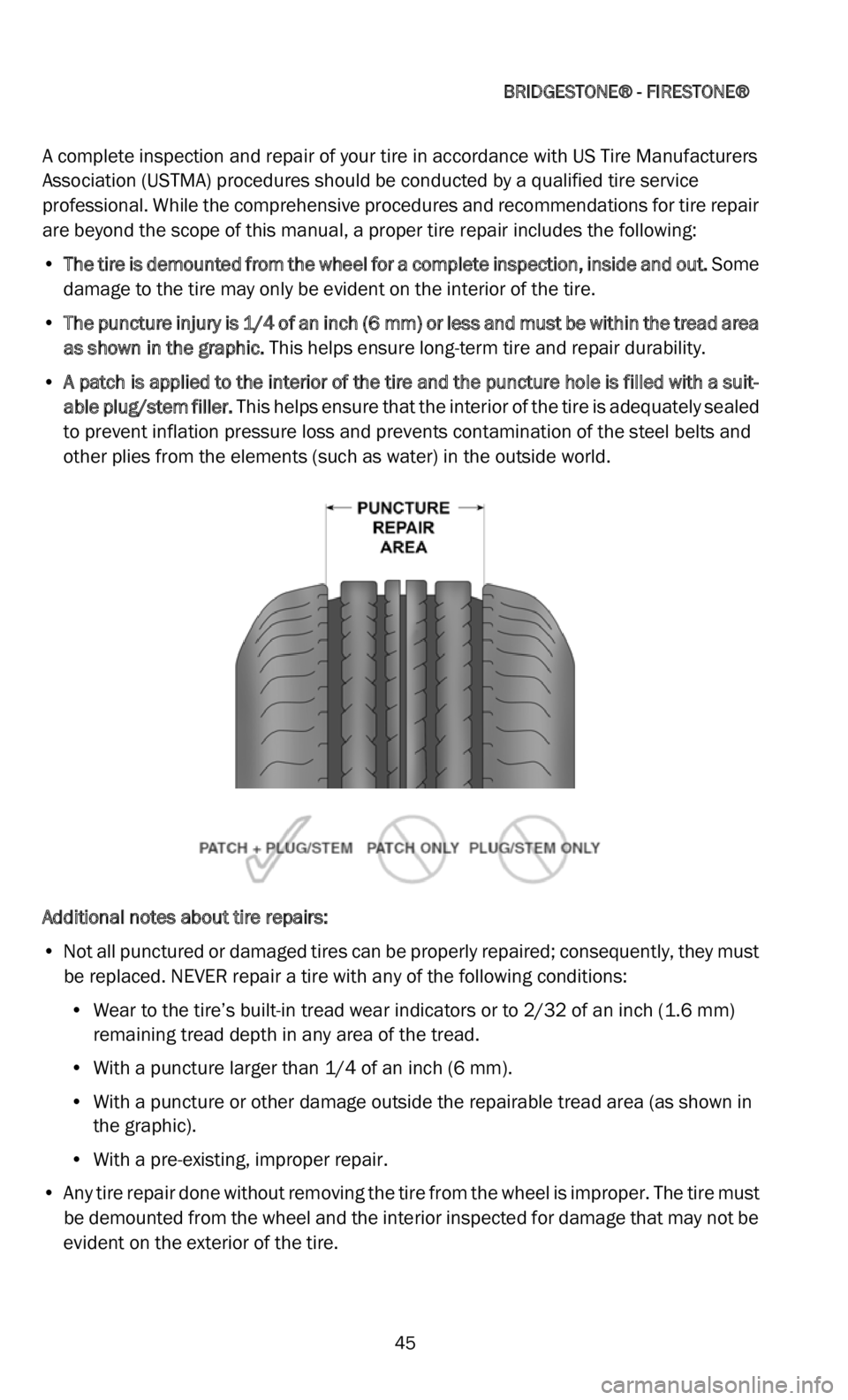
BRIDGESTONE® - FIRESTONE®
45
A complete inspection and repair of your tire in accordance with US Tire Manufacturers
Association (USTMA) procedures should be conducted by a qualified tire service
professional. While the comprehensive procedures and recommendations for tire repair
are beyond the scope of this manual, a proper tire repair includes the following:
• The tire is demounted from the wheel for a complete inspection, inside and out.
Some
damage to the tire may only be evident on the interior of the tire.
• The puncture injury is 1/4 of an inch (6 m
m) or less and must be within the tread area
as
shown in the graphic. This helps ensure long-term tire and repair durability.
• A patch is applied to the interior of the tire and the puncture hole is filled with a suit -
a
ble plug/stem filler. T
his helps ensure that the interior of the tire is adequately sealed
to prevent inflation pressure loss and prevents contamination of the steel belts and
other plies from the elements (such as water) in the outside world.
Additional notes about tire repairs:
• N ot all punctured or damaged tires can be properly repaired; consequently, they must
b
e replaced. NEVER repair a tire with any of the following conditions:
• W ear to the tire’s built-in tread wear indicators or to 2/32 of an inch (1.6
mm)
re
maining tread depth in any area of the tread.
• W ith a puncture larger than 1/4 of an inch (6
mm).
• W ith a puncture or other damage outside the repairable tread area (as shown in
t
he graphic).
• W ith a pre-existing, improper repair.
•
A ny tire repair done without removing the tire from the wheel is improper. The tire must
b
e demounted from the wheel and the interior inspected for damage that may not be
evident on the exterior of the tire.
Page 47 of 200

BRIDGESTONE® - FIRESTONE®
46
• Using only a plug/stem, or using only a patch, is not a safe or proper repair. A patch must be applied to the interior of the tire and the puncture hole must be filled with a
suitable plug/stem filler to prevent inflation pressure loss and contamination of the
steel belts and other plies.
• N EVER substitute a tube for a proper repair or to remedy an improper repair.
•
Tubes, like tires, should only be repaired by a qualified tire service professional.
•
Some vehicle manufacturers do not recommend using repaired tires. Consult your
v
ehicle Owner’s Manual or contact the vehicle manufacturer before operating a
repaired tire on your vehicle.
ASK how your tire will be repaired. ALWAYS insist on a proper tire repair.
Emergency/Temporary Sealant or Filler Repairs: A
n emergency/temporary sealant or
filler injected into the tire, such as by aerosol can or injection/squeeze-tube, is not a
proper repair and voids the tire Limited Warranty. A tire injected with such sealant/filler
must be replaced by a qualified tire service professional as soon as possible.
Speed Rating: T
he tire’s speed rating is void if the tire is repaired, retreaded, damaged,
abused, or otherwise altered from its original condition. Thereafter, it should be treated
as a non-speed rated tire. See “Tire Speed Ratings” in this manual.
Improper repair voids the tire Limited Warranty. S
ee “Limited Warranty” in this manual.
RFT (Run-Flat Technology) Tires: I
n addition to the above, there are recommendations
specific to the repair of RFT tires; see “RFT Tires with Run-Flat Technology” in this
manual.
TIRE MOUNTING AND OTHER SERVICING
WARNING!
Tell the tire service professional if you have used an aerosol fixer to inflate/seal the
tire. Aerosol fixers could contain a highly volatile gas. Always remove the valve core
outdoors, away from sources of excessive heat, flame, or sparks and completely
deflate the tire before removing it from the wheel.
WARNING!
Removing and replacing tires on wheels can be dangerous. Attempting to mount tires
with improper tools or procedures may result in a tire explosion causing serious
personal injury or death. This is only a job for a qualified tire service professional.
Never perform tire service procedures without proper training, tools, and equipment.
Page 48 of 200

BRIDGESTONE® - FIRESTONE®
47
This manual is not intended to provide proper training or service procedures for tire
mounting, demounting, balancing, rotation, or repair. Please leave these tasks to
qualified tire service professionals. For your safety and that of others:
• A lways stand well clear of any tire mounting operation. This is especially important
w
hen the service operator inflates the tire. If the tire has been improperly mounted, it
may burst with explosive force causing serious personal injury or death.
• T ires must match the width and diameter requirements of the wheels. For example,
1
6 inch diameter tires must only be mounted to 16 inch diameter wheels. Radial tires
m u
st only be mounted to wheels approved for radial tires.
• W heels must be free of cracks, dents, chips, and rust. Tires must be free of bead
d
amage, cuts, and punctures.
• N ever inflate a tire beyond 40 psi (275 kPa) to seat the beads. Be absolutely certain
b
eads are fully seated before adjusting inflation pressure to the level recommended
for vehicle operation.
• N ever put flammable substances in tire/wheel assemblies at any time. Never put any
f
lammable substance into a tire/wheel assembly and attempt to ignite to seat the
beads.
• A lways stand well away from the work area when tires are being spin balanced either
o
n or off the vehicle.
HIGH PERFORMANCE, LOW ASPECT RATIO TIRES
Many new vehicles come equipped from the factory with high performance and/or low
aspect ratio tires. Generally, these tires provide increased vehicle handling capability,
but may also have numerous engineering performance trade-offs associated with their
designs.
• Lo w aspect ratio tires, with reduced sidewall height, may be more susceptible to
d
amage from potholes, road hazards, and other objects such as curbs. This is true for
the wheels as well. Therefore, as with all other tires, it is important to drive with care
and maintain proper inflation pressure and load conditions. See “Tire Inflation Pres -
sure” and “Tire Damage, Inspection and Service Life” in this manual.
• Some sports cars and other handling performance enhanced vehicles, including s
edans and light trucks/SUVs, may be originally equipped with high performance tires
that are more optimized for warmer weather use. Colder, winter weather traction may
be reduced for these types of tires. Winter tires may be recommended by the vehicle
manufacturer for colder weather application. See “Winter Tires,” the next section in
this manual.
• H igh performance tires may also wear more quickly, ride more firmly, and produce
m
ore noise during operation.
Consult your vehicle Owner’s Manual and tire information placard, or a qualified tire
s e
rvice professional, for more information and specifics regarding these types of tires.
Page 49 of 200
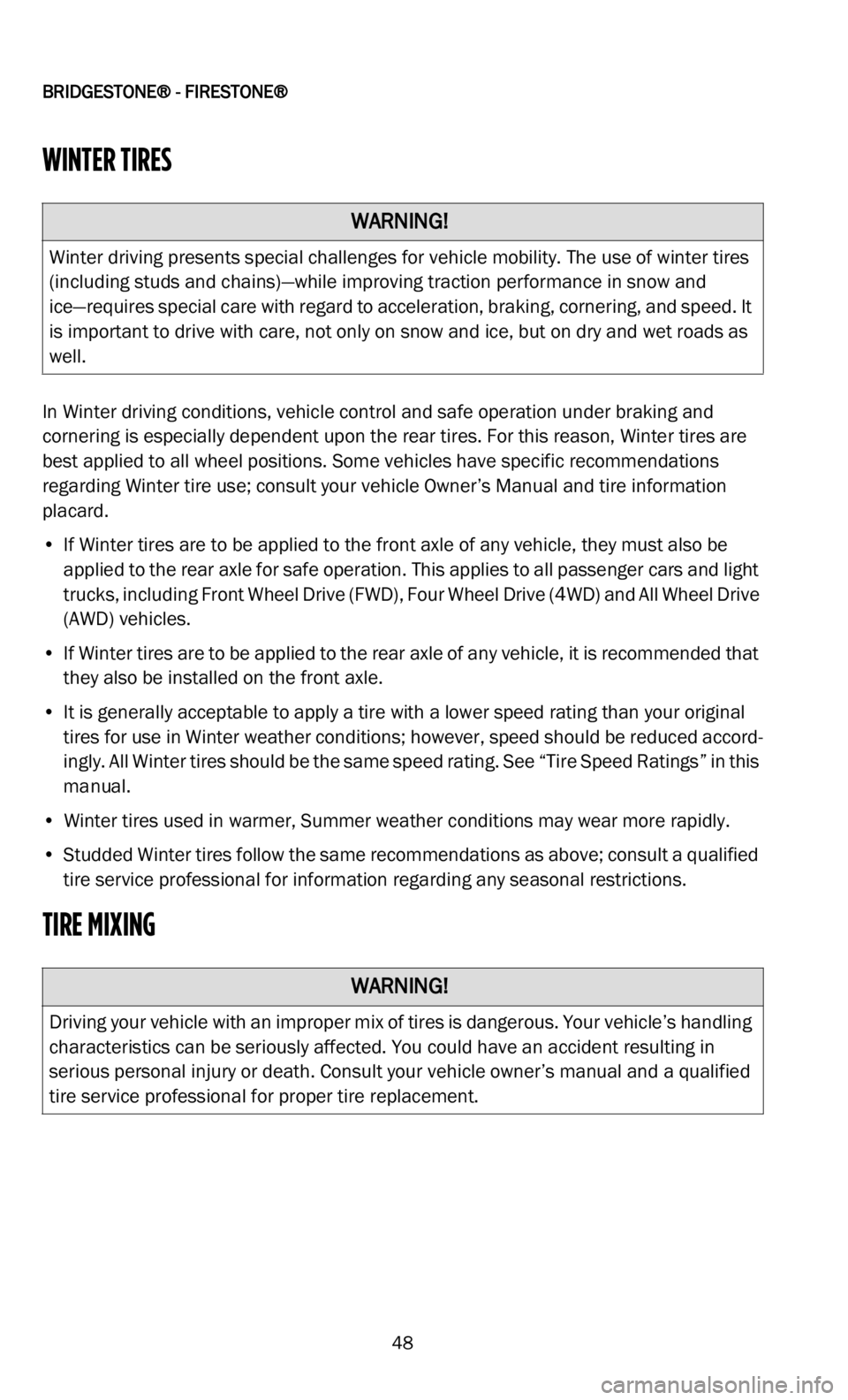
BRIDGESTONE® - FIRESTONE®
48
WINTER TIRES
In Winter driving conditions, vehicle control and safe operation under braking and
cornering is especially dependent upon the rear tires. For this reason, Winter tires are
best applied to all wheel positions. Some vehicles have specific recommendations
regarding Winter tire use; consult your vehicle Owner’s Manual and tire information
placard.
• If Winter tires are to be applied to the front axle of any vehicle, they must also be a
pplied to the rear axle for safe operation. This applies to all passenger cars and light
trucks, including Front Wheel Drive (FWD), Four Wheel Drive (4WD) and All Wheel Drive
(AWD) vehicles.
• I f Winter tires are to be applied to the rear axle of any vehicle, it is recommended that
t
hey also be installed on the front axle.
• I t is generally acceptable to apply a tire with a lower speed rating than your original
t
ires for use in Winter weather conditions; however, speed should be reduced accord -
ingly. All Winter tires should be the same speed rating. See “Tire Speed Ratings” in this
m a
nual.
• W inter tires used in warmer, Summer weather conditions may wear more rapidly.
•
Studded Winter tires follow the same recommendations as above; consult a qualified
t
ire service professional for information regarding any seasonal restrictions.
TIRE MIXING
WARNING!
Winter driving presents special challenges for vehicle mobility. The use of winter tires
(including studs and chains)—while improving traction performance in snow and
ice—requires special care with regard to acceleration, braking, cornering, and speed. It
is important to drive with care, not only on snow and ice, but on dry and wet roads as
well.
WARNING!
Driving your vehicle with an improper mix of tires is dangerous. Your vehicle’s handling
characteristics can be seriously affected. You could have an accident resulting in
serious personal injury or death. Consult your vehicle owner’s manual and a qualified
tire service professional for proper tire replacement.
Page 53 of 200
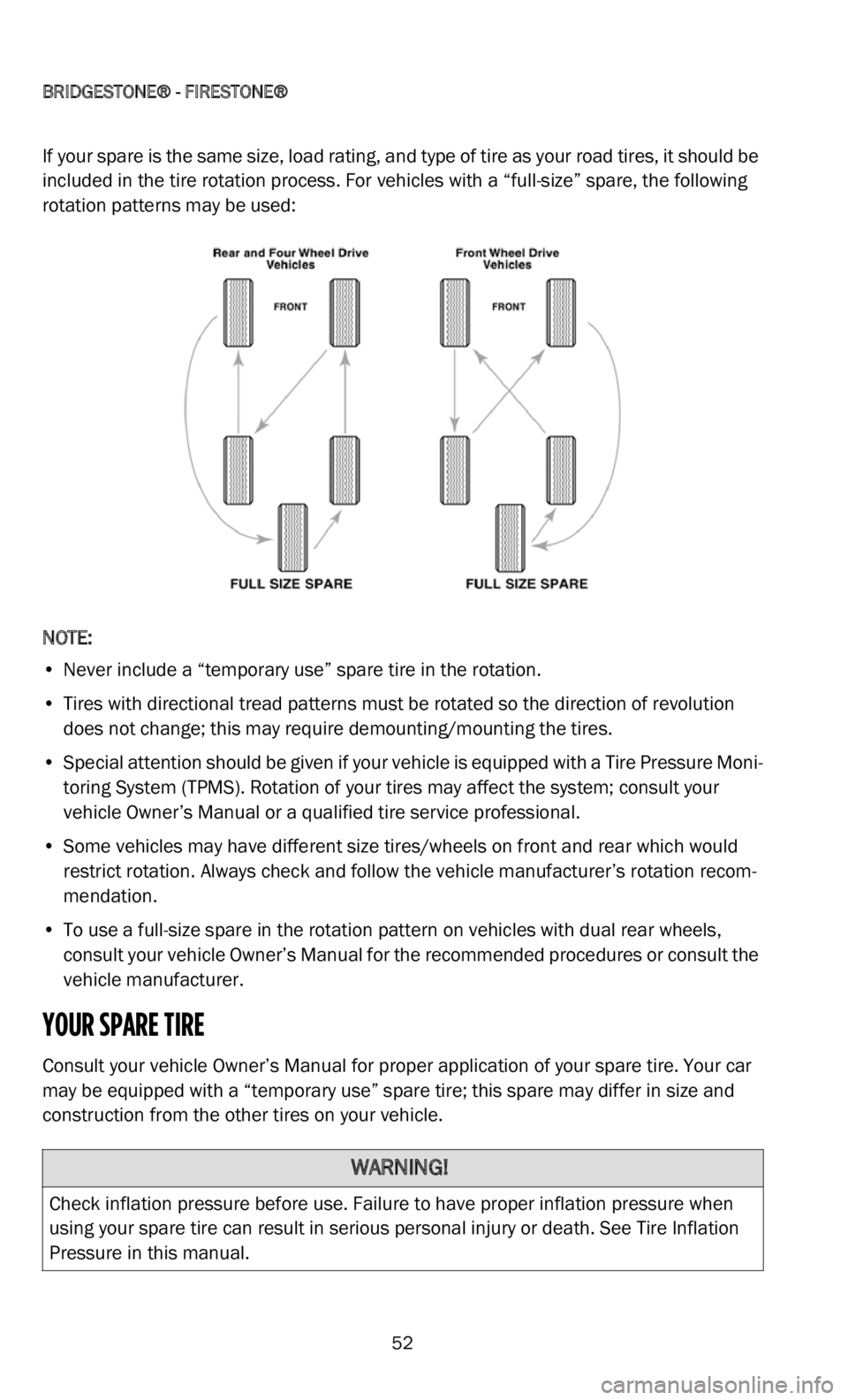
BRIDGESTONE® - FIRESTONE®
52
If your spare is the same size, load rating, and type of tire as your road tires, it should be
included in the tire rotation process. For vehicles with a “full-size” spare, the following
rotation patterns may be used:
NOTE:
• Never include a “temporary use” spare tire in the rotation.
•
Tires with directional tread patterns must be rotated so the direction of revolution
d
oes not change; this may require demounting/mounting the tires.
• S pecial attention should be given if your vehicle is equipped with a Tire Pressure Moni -
t
oring System (TPMS). Rotation of your tires may affect the system; consult your
v e
hicle Owner’s Manual or a qualified tire service professional.
• S ome vehicles may have different size tires/wheels on front and rear which would
r
estrict rotation. Always check and follow the vehicle manufacturer’s rotation recom -
mendation.
• T o use a full-size spare in the rotation pattern on vehicles with dual rear wheels,
c
onsult your vehicle Owner’s Manual for the recommended procedures or consult the
vehicle manufacturer.
YOUR SPARE TIRE
Consult your vehicle Owner’s Manual for proper application of your spare tire. Your car
may be equipped with a “temporary use” spare tire; this spare may differ in size and
construction from the other tires on your vehicle.
WARNING!
Check inflation pressure before use. Failure to have proper inflation pressure when
using your spare tire can result in serious personal injury or death. See Tire Inflation
Pressure in this manual.
Page 54 of 200
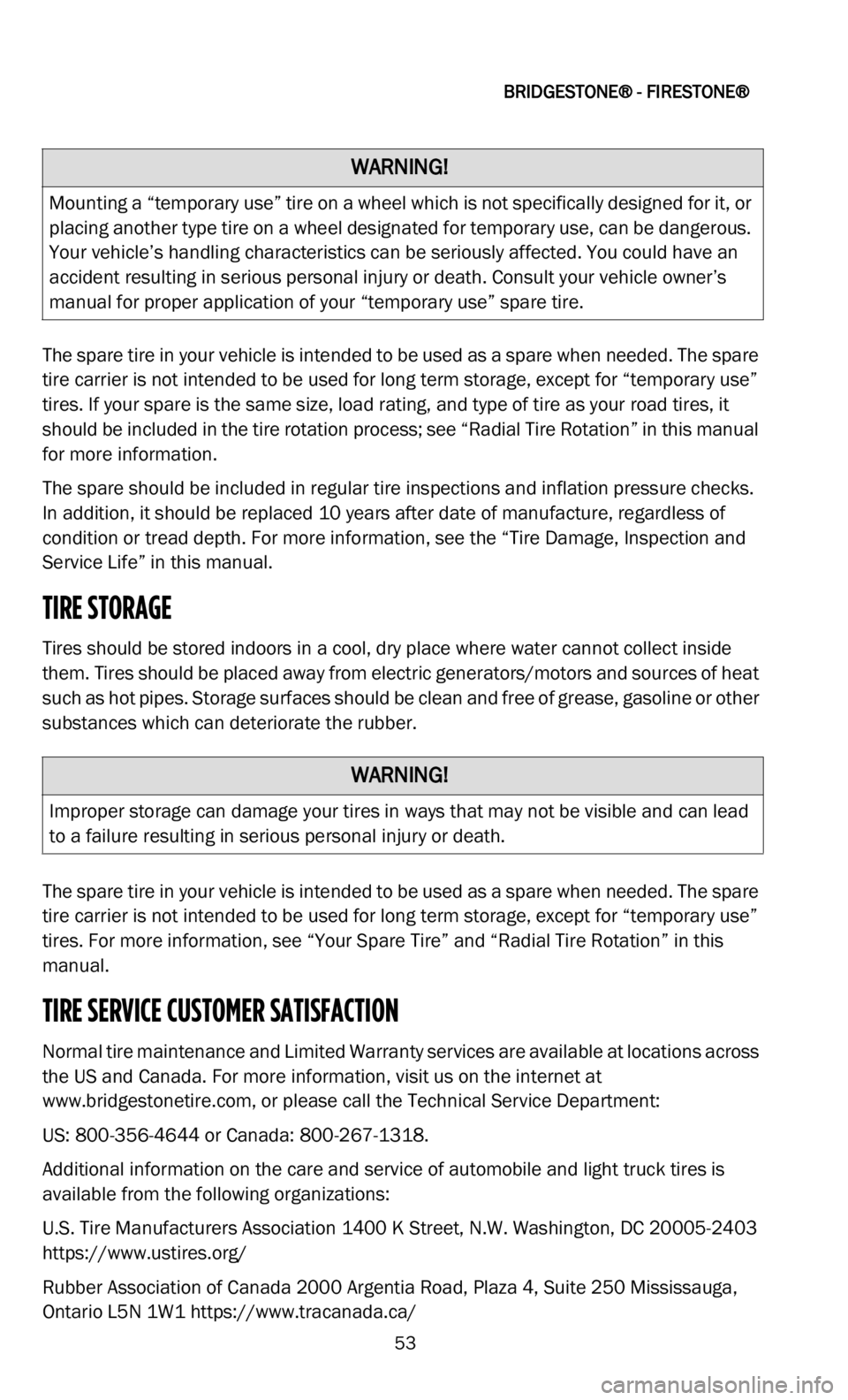
BRIDGESTONE® - FIRESTONE®
53
The spare tire in your vehicle is intended to be used as a spare when needed. The spare
tire carrier is not intended to be used for long term storage, except for “temporary use”
tires. If your spare is the same size, load rating, and type of tire as your road tires, it
should be included in the tire rotation process; see “Radial Tire Rotation” in this manual
for more information.
The spare should be included in regular tire inspections and inflation pressure checks.
In
addition, it should be replaced 10 years after date of manufacture, regardless of
condition or tread depth. For more information, see the “Tire Damage, Inspection and
Service Life” in this manual.
TIRE STORAGE
Tires should be stored indoors in a cool, dry place where water cannot collect inside
them. Tires should be placed away from electric generators/motors and sources of heat
such as hot pipes. Storage surfaces should be clean and free of grease, gasoline or other
substances which can deteriorate the rubber.
The spare tire in your vehicle is intended to be used as a spare when needed. The spare
t i
re carrier is not intended to be used for long term storage, except for “temporary use”
tires. For more information, see “Your Spare Tire” and “Radial Tire Rotation” in this
manual.
TIRE SERVICE CUSTOMER SATISFACTION
Normal tire maintenance and Limited Warranty services are available at locations across
the US and Canada. For more information, visit us on the internet at
www.bridgestonetire.com , or please call the Technical Service Department:
US: 8 00-356-4644 or Canada: 800-267-1318.
A
dditional information on the care and service of automobile and light truck tires is
a v
ailable from the following organizations:
U.S. Tire Manufacturers Association 1400 K Street, N.W. Washington, DC 20005-2403
https://www.ustires.org/
Rubber Association of Canada 2000 Argentia Road, Plaza 4, Suite 250 Mississauga,
O n
tario L5N 1W1 https://www.tracanada.ca/
WARNING!
Mounting a “temporary use” tire on a wheel which is not specifically designed for it, or
placing another type tire on a wheel designated for temporary use, can be dangerous.
Your vehicle’s handling characteristics can be seriously affected. You could have an
accident resulting in serious personal injury or death. Consult your vehicle owner’s
manual for proper application of your “temporary use” spare tire.
WARNING!
Improper storage can damage your tires in ways that may not be visible and can lead
to a failure resulting in serious personal injury or death.
Page 55 of 200

BRIDGESTONE® - FIRESTONE®
54
TIRE REGISTRATION
Registration of your tires is an important safety precaution since it enables the
manufacturer to notify you in the event of a recall. When you purchase replacement tires,
the retailer will provide a registration card on which the tire identification numbers have
been recorded; fill in your name and address on the card and mail it promptly. Some
retailers may submit the registration for you. You do not need to register tires which come
as original equipment on new vehicles—the vehicle and tire manufacturers handle that
for you.
RFT TIRES WITH RUN-FLAT TECHNOLOGY
If your vehicle is equipped with Bridgestone® or Firestone® brand RFT
tires, this chapter presents specific maintenance and safety issues
a s
sociated with these tires that are in addition to those covered elsewhere in this
manual.
What is RFT? Run-Flat Technology tires are extraordinary tires that utilize specially
d e
signed components to temporarily support your vehicle in the event of inflation
pressure loss, such as from a puncture. This gives you the ability to drive to a convenient
and safe location to change your tire (if equipped with a spare) or have it inspected for
possible repair or replacement.
Naturally, certain run-flat and low pressure operating limitations apply, which varies
ac
cording to the specific self-supporting tire design. Like all tires, during normal
operation, they must be properly inflated and maintained. Regardless of the design or
quality, no tire is indestructible.
RFT — How to Identify: B
ridgestone® and Firestone® brand tires are marked on the
sidewalls, near the wheel, with the RFT logo (shown above).
RFT INFLATION PRESSURE
Like other tires, RFT tires need proper inflation pressure maintenance for safe operation
an
d to achieve the maximum tire life and performance. Check inflation pressures
monthly and before long trips or carrying extra weight. Use an accurate tire gauge and
check pressures when the tires are cold. Follow the vehicle manufacturer’s
recommendation for inflation pressure settings as indicated on the vehicle tire
information placard and/or in the vehicle Owner’s Manual. Do not forget the spare, if
applicable. See “Tire Inflation Pressure” in this manual.
TIRE PRESSURE MONITORING SYSTEM (TPMS)
A functioning Tire Pressure Monitoring System (TPMS) must be used with your Run Flat
tires. These tires ride so well even without inflation pressure, the TPMS may be necessary
to alert you of an inflation pressure loss condition. When alerted, follow the instructions
in your vehicle Owner’s Manual and see “Run-Flat or Low Tire Pressure Operation,” the
following section in this manual.
Page 56 of 200

BRIDGESTONE® - FIRESTONE®
55
The vehicle or TPMS manufacturer may advise checking the TPMS regularly to confirm it
is in working order. In addition, a new pressure sensor, certain components, or
reprogramming may be necessary when a tire is serviced. Consult your vehicle Owner’s
Manual, vehicle manufacturer, or a Bridgestone® Firestone® Run-Flat Certified Retailer
for questions regarding TPMS operation and service.
RUN-FLAT OR LOW TIRE PRESSURE OPERATION
General Instructions
The Tire Pressure Monitoring System (TPMS) required in your vehicle may have different
m e
thods of alerting you when your tire has lost inflation pressure. The international
standard for the definition of run-flat operation is pressure at or below 10 psi (70 kPa);
however, some vehicle manufacturers may have established a different pressure limit.
Consult your vehicle Owner’s Manual for the details of your TPMS. Once the TPMS has
indicated that a tire has reduced inflation pressure, the run-flat mode of operation has
commenced. During this phase of operation, please follow these instructions:
• Reduce speed as much as safely and reasonably possible; do not exceed 50 m
ph
(8
0 km/h). The greater the speed, the less distance the tire can travel.
• Avoid abrupt or aggressive acceleration, braking, or cornering maneuvers as much as
s
afely and reasonably possible. Pot holes and other road hazards should be avoided.
Careful driving limits potential damage to the tire, wheel, and vehicle.
• Proceed to a safe and convenient location for tire service as soon as possible.
Take
note of your mileage; your operation distance is limited. See "Distance—How Far You
Can Drive,” the next section in this manual.
• If an unusual vibration or vehicle handling difficulty arises, stop driving as soon as
s
afely and reasonably possible. The tire may be about to suddenly fail. Release the
accelerator and gradually reduce speed. The tire will need to be replaced before
proceeding.
• If towing a trailer, stop driving as soon as safely and reasonably possible. In this condi -
t
ion, it is potentially dangerous to operate a vehicle/trailer combination. I
f possible,
disconnect the trailer and proceed as noted above. Do not continue to tow any trailer
until proper tire service or replacement has been performed.
• Do not touch a tire recently run-low or run-flat (it may be very hot).
Allow the tire to cool
before handling.
WARNING!
Serious personal injury or death may result from a tire failure or accident due to
improper run-flat or low tire pressure operation. Read and follow the instructions
below, and the other maintenance and safety recommendations elsewhere in this
manual.
Page 58 of 200

BRIDGESTONE® - FIRESTONE®
57
RFT Tire Replacement
Do not replace or mix RFT tires with conventional tires, unless on an emergency/
t e
mporary basis. Conventional tires do not have run-flat capability and the handling
characteristics of the vehicle with these tires may be different. If a conventional tire is
used on an emergency/temporary basis, verify that its size, load capacity, inflation
pressure, and speed rating specifications meet the requirements of the vehicle. Replace
any conventional tire with the proper RFT tire as soon as possible.
RFT Tire Damage and Repair
No tire, regardless of its design or quality is indestructible. RFT tires can be ultimately
r e
ndered unusable due to a puncture or other road hazard as well as from improper
run-flat or low tire pressure operation. Some punctures may be repaired under certain
restrictions and prescribed procedures.
When driven flat or with low pressure, factors affecting reparability include vehicle speed,
l o
ad, and maneuvering; the amount of inflation pressure loss; and ambient temperature.
In any situation, the extent and location of direct damage from a puncturing object or
other road hazard are also critical factors.
RFT tires are not repairable in any of the following situations:
• I f the tire was operated with inflation pressure less than 15 psi (100 kPa).
•
Abrasion or other damage is present on the exterior tread, sidewall or bead areas.
•
Abrasion, wrinkling, or separation is present on the tire interior.
•
Any condition or damage is present that disqualifies repair of a conventional tire.
R
un-Flat Certified Retailers will fully inspect your tire, inside and out, to determine if the
t i
re can be repaired. Tire damage is not always visible from the outside and the tire must
be removed from the wheel for a complete inspection. For more information, see the
section “Tire Repairs” in this manual.
NOTE:
Some vehicle manufacturers do not recommend using repaired tires. Consult your
v e
hicle Owner’s Manual or contact the vehicle manufacturer before operating a repaired
tire on your vehicle.